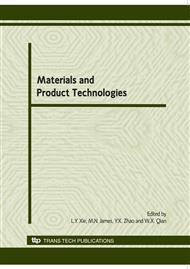p.1
p.10
p.17
p.27
p.32
p.37
p.43
p.49
Distribution of Fatigue Lives for the Diecast Magnesium Alloy
Abstract:
. In this study, fatigue tests were carried out using a diecast Mg alloy AZ91 to study the distribution of fatigue lives under constant stress amplitudes. During the fatigue process of the diecast Mg alloy, cracks initiated from the casting defect within inside of the specimen, and then propagated prior to final failure of the specimen. Distributions of fatigue lives at the constant stress amplitudes can be represented by the Weibull distributions. The scatter in the distribution of fatigue lives becomes larger at the lower stress amplitude of 80 MPa as compared with those at the higher stress amplitudes. There is a common relationship regardless of the stress amplitudes between the initial maximum stress intensity factors Kimax and fatigue lives Nf. The lower Kimax, the longer Nf becomes. Integrating the fatigue crack propagation law from the initial maximum stress intensity factor Kimax to the fatigue fracture toughness Kfc, the relation Kimax vs. Nf can be successfully evaluated.
Info:
Periodical:
Pages:
27-31
Citation:
Online since:
June 2010
Price:
Сopyright:
© 2010 Trans Tech Publications Ltd. All Rights Reserved
Share:
Citation:


